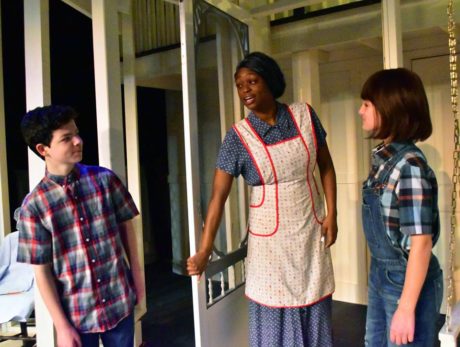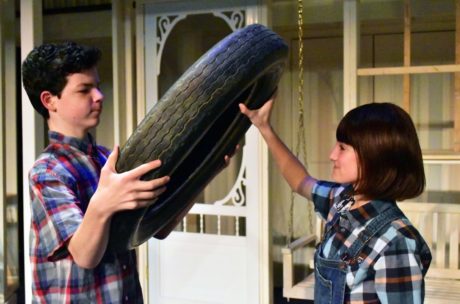In a scene of fierce confrontation between Atticus Finch and Bob Ewell in Providence Players’ production of To Kill a Mockingbird, Ewell insults Atticus in such a vicious way, that one wonders why Atticus doesn’t take physical revenge on him. When asked about the incident, Atticus said he wished Ewell would “not chew tobacco,” a statement that painted Atticus as the living definition of a long-suffering stoic—totally in command of his reaction to life’s injustices. Expertly directed by Beth Gilles-Whitehead, Providence Players of Fairfax’s To Kill a Mockingbird is easily one of the top five shows on D.C. area stages this year, worthy of every accolade and award it may receive.

To Kill a Mockingbird, an American classic based on the Pulitzer prize-winning novel by the late Harper Lee and adapted to the stage by Christopher Sergel, explores many racial, philosophical and justice-based themes that are relevant today because they are so timeless. In Maycomb, Alabama, October 1935, a young, married, Black father of three, Tom Robinson, is on trial for raping a 19-year-old White woman, Mayella Ewell. It is lawyer Atticus Finch who accepts the call from Judge Taylor to defend Robinson even though Atticus sees himself in the position of being “licked before you begin, but you begin anyway.”
The story was narrated by the stage version of Lee and her fictional creation\alter ego Jean Louise “Scout” Finch. Kristin Wahlne created a believable Lee, who spent much of the play sitting house right of the proscenium stage at a typewriter observing the action. The unmitigated star, upon whichthe whole of the production rested and excelled was Sophia Manicone, who in look, body language and attitude, masterfully embodied Scout.
Scout’s friend Dill, whom the real Lee based on childhood friend and famous true crime author Truman Capote, was played with a wise-beyond-his years feistiness by Caden Mitchell; he and Manicone had a strong rapport in their scenes. Brendan Dure brought a steady assurance to Scout, as her older brother Jeremy “Jem” Finch.
Robert Heinly’s performance as Atticus Finch was in a word, breathtaking. Spot on. Brillant. Perfect. Whatever superlative you can think of for his portrayal, it would match. Heinly shone in his scenes with his children, his scenes with the town authority figures and especially his courtroom scene.
Philip Kershaw’s Robinson, clad in simple overalls, and sporting a crippled left arm, did much with a role of few words. One of the more telling bits of dialogue for Robinson was his lament during his trial that ”if you were a nigger like me you’d be scared too.”
Robinson’s infuriating accuser, Mayella Ewell, was played with a combination of vulnerability and repressed rage by Ariana Colligan; Mayella’s father Bob was portrayed by Michael Donahue as an angry lout, a “victim of cruel poverty and ignorance” somewhat similar to Jeeter Lester, the protagonist in Erskine Caldwell’s novel Tobacco Road who lived near the Black section of town.

The elderly, racist Mrs. DuBose, who complained that Atticus ”goes against his race”, was brilliantly played by Mona Kay Helper. The gossipy neighbors Stephanie Crawford and Maudie Atkinson were well played by Robey Manno and Janet Kohler Dueweke respectively. Mihara India was strong in her scenes as the Finch’s maid, Calpurnia, as was Eric Jones as Reverend Sykes. Sheriff Tate and Judge Taylor came to life as steady authority figures thanks to Bob Thompson and Kevin Harnisch respectively.
In an unforgettable scene, as the reclusive and introverted Arthur “Boo” Radley, Christopher Crockett conveyed much characterization without saying a word. Crockett’s performance, because of its understatedness, was brilliant.
As the play went on, I grew to like Director Gilles-Whitehead use of a ramp in front of the stage and of the house’s wings and aisles to shuttle actors in and out of scenes. Gilles-Whitehead’s direction lived up to her director’s note about theater being able to “stand up to injustice; speak up for the innocent; and change the world with love and humility.”
I loved Set Designers Patrick and Ingrid Helvig David’s genius use of scenery wagons that allowed the heavily screen-doored-and-windowed Finch house to revolve and become a jail, and for all of the houses to be rolled off stage to reveal a courtroom. Boo Radley’s stage right house, which remained stationary, was all wooden planks and boards. Amanda Ranowsky and Julie Janson’s costume design, which included Heinly’s cream colored suit, was superb. Lighting Designer Chip Gertzog effectively created lightning in a pivotal scene.
To Kill a Mockingbird is an educational stage gem of the highest luster, fit for young and old, singles and families, and all those who wish to observe and learn from some of the bitter lessons of America’s past.
Running Time: 2 hours and 15 minutes, with a 15-minute intermission.
To Kill a Mockingbird plays through April 8, 2017 at Providence Players of Fairfax, performing at the James Lee Community Center Theater – 2855 Annandale Road, in Falls Church, VA. For tickets, call the box office at (703) 425-6782, or purchase them Sophia Manicone, who in look, body language and attitude, masterfully embodied Scout..





